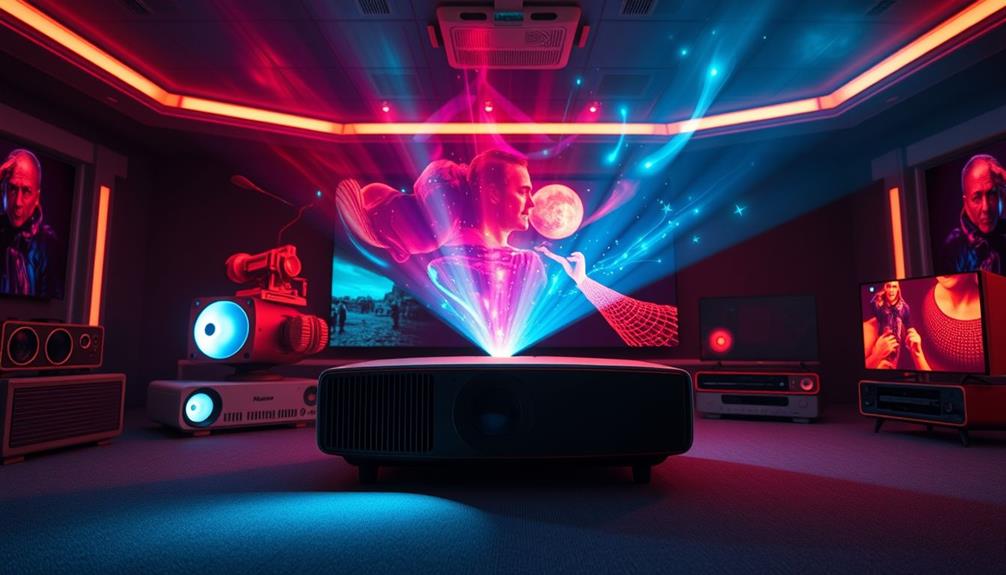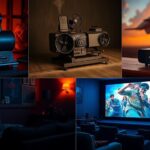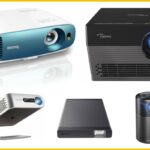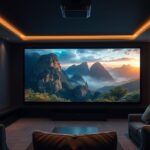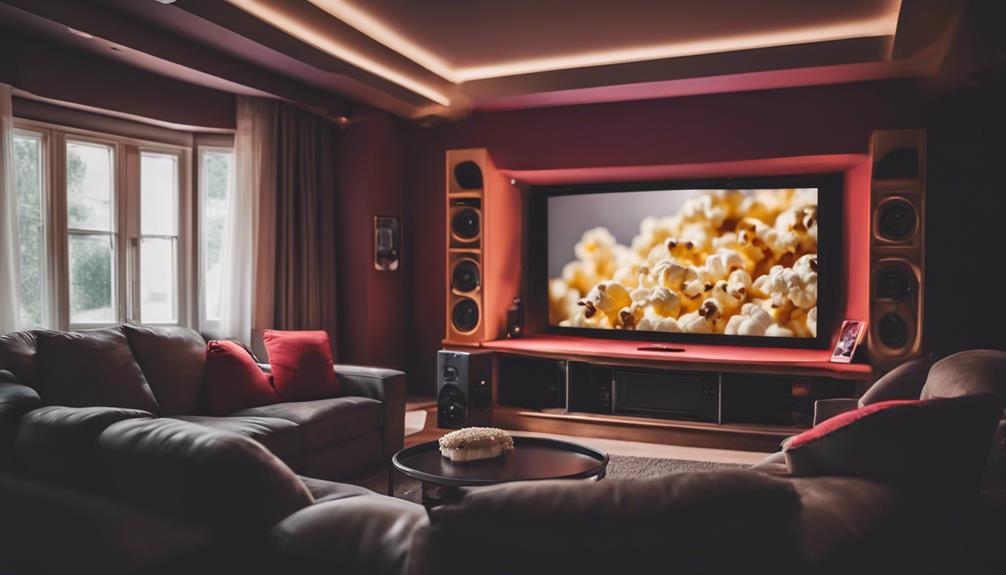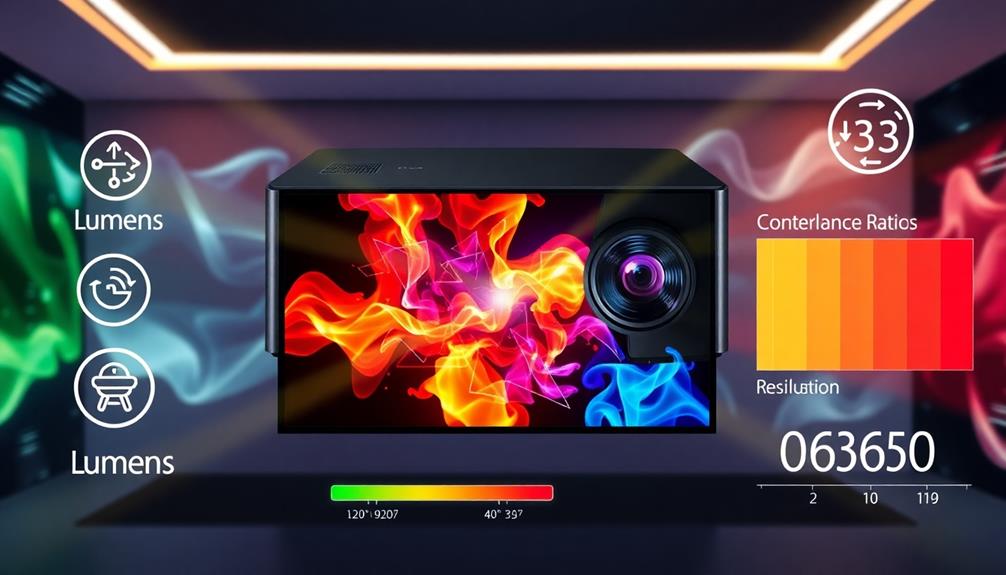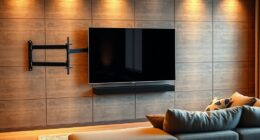Projector technology has come a long way from basic candle-lit models to today's high-definition digital units. You can expect future innovations to include more compact designs and advanced features like AI integration, which will enhance user experience. Laser projectors are gaining popularity for their brilliant colors and longer lifespans. The rise of pocket projectors makes portability a priority, while immersive technologies like virtual and augmented reality are set to transform visual experiences. With a growing demand for multifunctional devices, the future looks promising. Discover what else lies ahead in the ever-evolving world of projection technology.
Key Takeaways
- Projector technology has evolved from early devices like the Magic Lantern to advanced digital projectors with superior image quality and brightness.
- The integration of AI and smart technology enhances user experience, enabling seamless connectivity and automated features in modern projectors.
- The rise of compact and pocket projectors offers enhanced portability, making it easier to deliver presentations in various settings.
- Emerging technologies, such as virtual and augmented reality, promise immersive experiences, expanding the applications of projection technology.
- The global projector market is expected to grow significantly, driven by consumer demand for high-quality visuals and multifunctional capabilities.
Historical Context of Projectors
The journey of projector technology is intriguing, beginning with the Magic Lantern in the 17th century. These early devices used candles to project hand-painted glass slides, enchanting audiences with visual storytelling.
As time passed, the evolution of projectors took significant leaps. In the 1950s, overhead and film projectors emerged, allowing for more dynamic presentations. While slide projectors required images to be transferred to 35mm slides, overhead projectors utilized transparencies, enabling real-time annotations that enhanced interactive learning. Additionally, as audio-visual technology progressed, the introduction of essential components for home theaters began to shift the focus toward creating immersive viewing experiences.
By the late 1980s, digital projectors revolutionized the landscape, offering high-resolution images and transforming classrooms and boardrooms alike. You could now share detailed visuals with unparalleled image quality, making presentations more engaging and effective. The advancements in optics and light sources also played a significant role, overcoming the limitations of size and clarity that plagued earlier technologies.
Today, the integration of document cameras has also evolved projectors, cementing their place as essential tools in educational and business environments. These developments reflect a continuous drive for innovation, illustrating how projector technology has adapted to meet modern demands.
The history of projectors not only highlights their evolution but also sets the stage for future advancements.
Advancements in Projector Technology
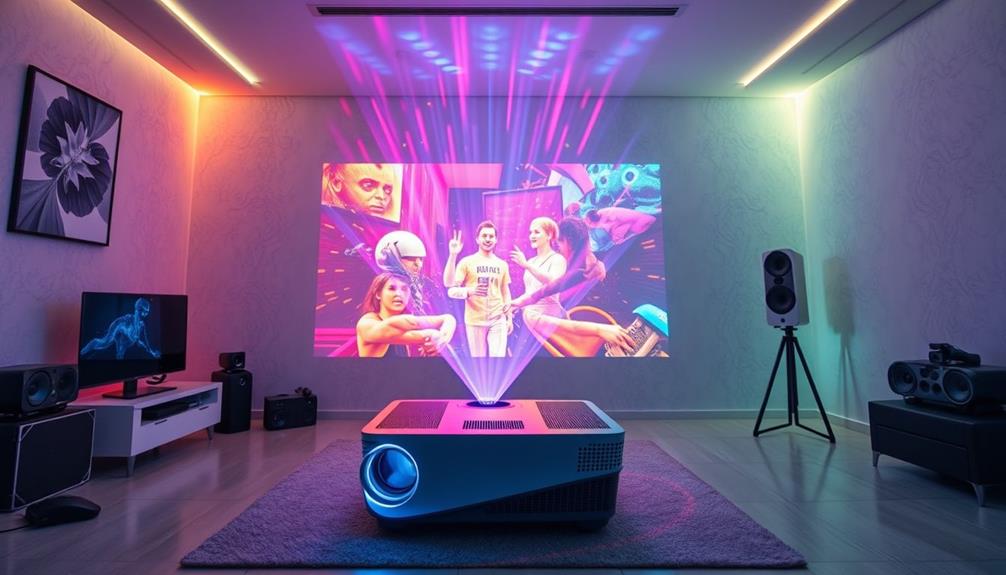
In recent years, projector technology has undergone remarkable advancements that have redefined how we experience visual content. The shift from traditional film to digital projectors in the early 21st century greatly improved image quality, enabling high-resolution displays that transformed presentations in education and business.
Modern projectors now utilize laser technology, offering brighter, more vibrant colors and longer lifespans, making them ideal for both home theaters and professional settings. Additionally, the integration of AI-driven solutions in various industries has enhanced user experiences, as these technologies can adapt to user preferences and optimize performance in real-time, similar to AI applications enhancing efficiency.
Moreover, the integration of 3D capabilities in projectors has created immersive viewing experiences, catering to the increasing demand for dynamic entertainment in cinemas and homes. Compact designs, such as pocket projectors, have emerged, enabling convenient on-the-go presentations and versatile applications across various environments.
Looking ahead, future trends suggest a potential fusion of smart technology and artificial intelligence in projectors. This could automate tasks, enhance user interactions, and adapt to individual preferences, offering a more personalized experience.
As these advancements continue, the way you engage with visual content will keep evolving, making projectors an indispensable tool in many aspects of life.
Projectors in Film and Entertainment
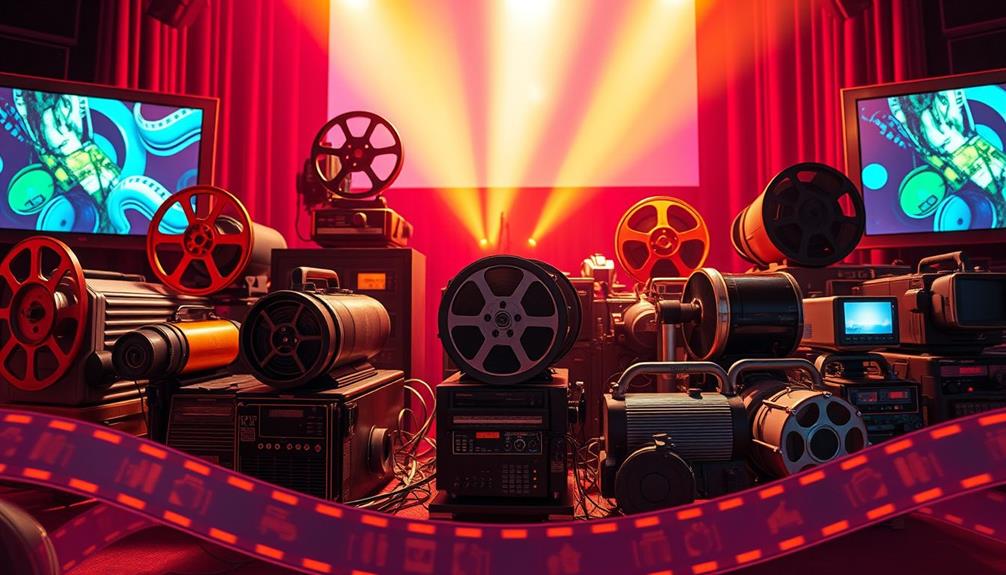
Projectors have transformed the film and entertainment landscape, providing audiences with stunning visuals that enhance storytelling. Since the late 20th century, digital projectors have revolutionized the industry by markedly improving image quality. They've eliminated pesky film scratches and wear, making your movie experience smoother than ever.
The introduction of 3D projectors has further captivated diverse audiences, with box office revenues for 3D films often surpassing traditional formats, elevating viewer engagement. Additionally, similar to the advancements seen in airless paint sprayers, projector technology has embraced innovation to enhance performance and user experience.
In your home entertainment setup, ultra-short throw projectors are game-changers. They allow you to project large images—over 100 inches—into smaller spaces, offering a cost-effective alternative to bulky flat-panel TVs.
Meanwhile, laser projectors have gained popularity in both cinemas and homes, delivering exceptional brightness, color accuracy, and longevity compared to older lamp-based models.
Don't forget about the gaming world! Projectors are enhancing gameplay experiences with high-definition visuals and low latency, essential for modern gaming setups.
As projector technology continues to evolve, you can expect even more immersive experiences, whether you're watching the latest blockbuster or diving into an epic gaming session.
Educational Applications of Projectors
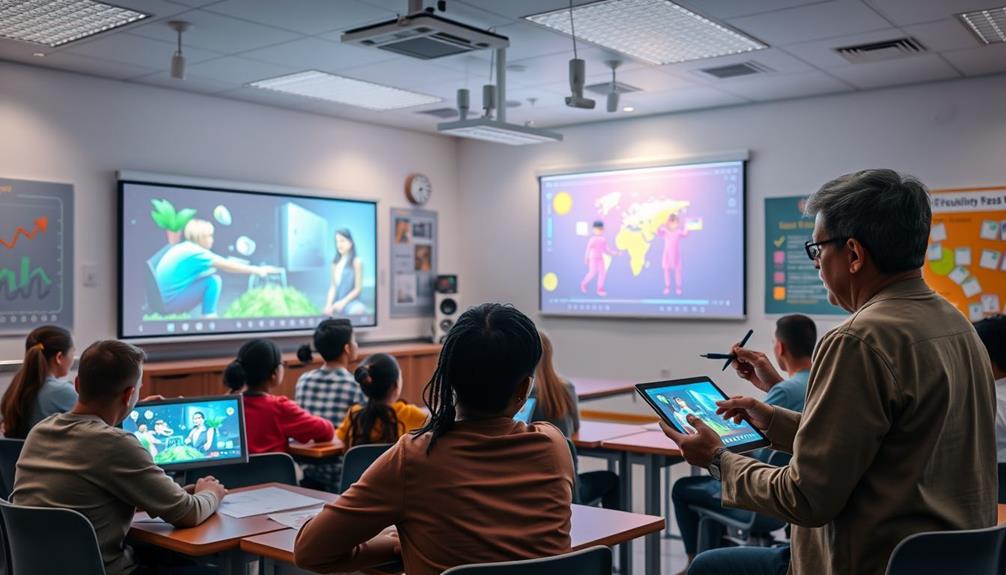
Countless classrooms now thrive with the use of projectors, which greatly enhance student engagement and comprehension. These devices allow teachers to project images that clarify complex concepts, making lessons more interactive and visually appealing.
In educational settings, modern projectors have become essential tools, supporting a variety of teaching methods and accommodating diverse learning styles. The impact of technology on education is profound, as seen in breathtaking destinations that promise adventure and unique cultural experiences.
With features like wireless presentations and connections to HD sources, modern projectors use technology to create versatile learning environments. This flexibility enables educators to integrate collaboration tools, considerably boosting student participation.
When you project large-scale visuals, it not only captures attention but also supports differentiated instruction, catering to various needs in the classroom.
Technological advancements in projector brightness and image quality have further solidified their role in contemporary education. By creating immersive learning experiences, projectors enhance classroom engagement, making lessons memorable.
Whether it's for remote learning applications or traditional in-person classes, the impact of projectors on education is undeniable. As you embrace these advancements, you'll find that projectors are indispensable allies in fostering an engaging and effective learning atmosphere.
Business Use of Projectors
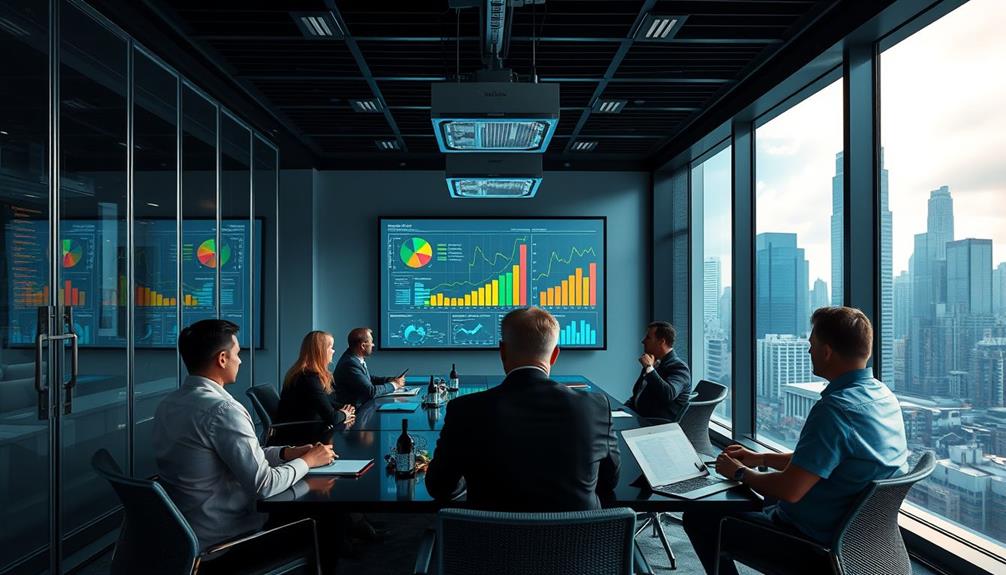
When you use projectors in corporate presentations, you enhance audience engagement and make complex data easier to understand.
This is particularly effective when you utilize strategies for increasing topical authority to guarantee your content resonates with your audience.
Their portability means you can set up meetings anywhere, making your presentations more accessible and flexible.
Plus, with advancements in technology, connecting to smart devices has never been simpler, assuring a smooth presentation experience.
Enhancing Corporate Presentations
In today's fast-paced corporate environment, effective communication is essential, and using projectors can greatly elevate your presentations. Modern projectors have become indispensable tools for conveying complex data and ideas through clear, engaging projected images. Their ability to enhance comprehension guarantees that your audience stays focused and retains critical information.
Additionally, incorporating best practices in software quality assurance into your presentation strategies can further improve clarity and effectiveness.
With the advent of digital projectors, image quality has seen significant improvements. High-definition visuals not only foster engagement but also make your corporate presentations more impactful. You'll find that integrating these projectors with smart devices and wireless connectivity simplifies the setup process, allowing you to deliver seamless presentations without extensive technical knowledge.
Moreover, projectors are a cost-effective solution for businesses looking to optimize their presentation tools. Compared to large display screens, they provide an affordable alternative while delivering a comparable, if not superior, viewing experience.
This budget-friendly aspect makes them ideal for companies of all sizes, enabling you to allocate resources more efficiently.
Portability and Accessibility Benefits
Harnessing the portability of modern projectors can greatly enhance your business presentations, providing flexibility that traditional setups lack. These compact devices are lightweight, easily fitting into your briefcase or backpack. This means you can effortlessly transport them for spontaneous presentations in various locations.
With features like wireless connectivity, modern projectors allow you to connect seamlessly to smart devices. This quick setup improves efficiency, letting you focus on your presentation rather than technical difficulties. Additionally, the cost-effectiveness of portable projectors compared to large display screens makes them an attractive choice for businesses aiming to maximize presentation capabilities while minimizing expenses.
Here's a quick overview of the benefits:
| Feature | Benefit |
|---|---|
| Portability | Easy transportation |
| Wireless Connectivity | Quick and seamless setup |
| Cost-Effectiveness | Affordable presentation option |
| Image Quality | Clear visuals in any lighting |
| Compact Design | Fits in bags for convenience |
Future Trends in Projection Technology
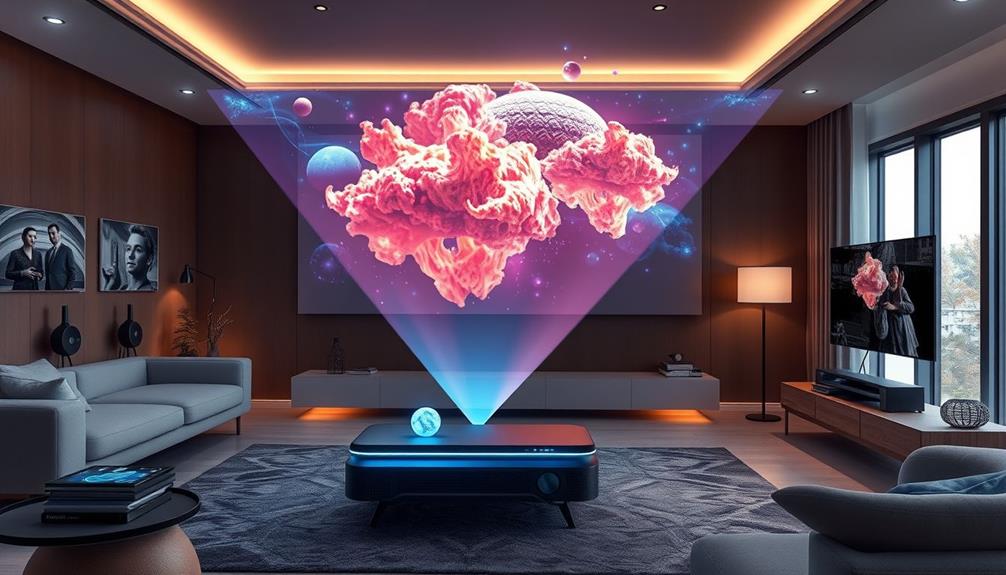
As projector technology continues to evolve, exciting future trends promise to reshape how you experience visual content. One of the most anticipated developments is the rise of pocket projectors. These devices enhance portability while improving resolution and performance through advanced technologies. Imagine having a high-quality projector that fits right in your pocket!
The integration of smart technology and artificial intelligence in projectors is also on the horizon. This means your projector could automate tasks and adapt to your preferences, making your viewing experience seamless and enjoyable.
Additionally, continuous innovation in design will lead to more compact and versatile projectors, catering to your demand for multifunctional solutions.
Virtual and augmented reality technologies are set to make a significant impact as well. These advancements could create immersive viewing experiences, transforming how you consume content across various sectors.
Consumer Expectations and Market Growth
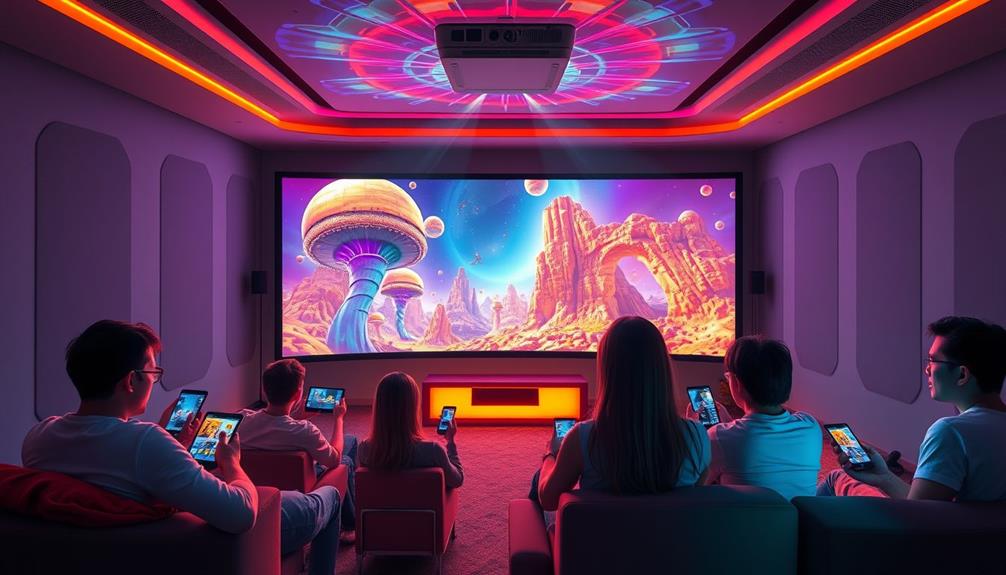
With an increasing focus on high-quality visuals, consumers are demanding more from compact projectors. You want advanced features like wireless connectivity, compatibility with various media types, and enhanced user-friendly interfaces.
These preferences reflect a significant shift in consumer expectations, pushing manufacturers to innovate continually. The growing popularity of WordPress themes also indicates a trend towards personalization and customization in technology, creating parallels in how consumers want to tailor their projector experiences.
The global projector market is projected to grow at a CAGR of around 8% from 2022 to 2027, driven by these technological advancements. As portable projectors become more popular, you're likely looking for multifunctional devices that adapt to both personal and professional settings.
Moreover, the rising demand for immersive experiences—such as 3D content and augmented reality—shapes what you expect from future projector innovations. You want devices that seamlessly integrate with your existing technology ecosystem, making it easy to create enchanting presentations or enjoy home entertainment.
As consumer expectations rise, the market will need to keep pace, ensuring that new projectors not only meet but exceed your demands. The future of projector technology looks promising, with enhanced features and smarter solutions on the horizon.
Conclusion
As we look to the future of projector technology, it's clear that innovation is just around the corner. Imagine a world where your favorite films burst to life in stunning detail, or where classrooms become immersive learning environments. With every pixel, we're not just witnessing a shift; we're participating in a revolution. So, why not embrace these advancements? After all, the next big leap in projection could transform how we share stories, ideas, and experiences together.
Hello, I’m Art, and I’m excited to be a part of the 1Home Theatre Projector team. As a writer, I’m here to contribute my knowledge and insights to help you achieve the ultimate home cinema experience. I understand that making decisions in the world of home entertainment can be complex, and I’m here to simplify the process for you.
